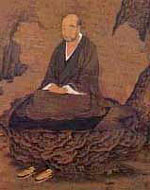Koso Wasan 44
T'an-luan teaches that the Buddhas adorn their
three modes of action,
So that they are characterised by ultimate nondiscrimination;
This is to heal the bodily, verbal and mental acts of beings,
Which are false and delusional.
The Three Modes of Action

Every Buddha has a history. Every Buddha results from a bodhisattva career. Amida Buddha is no different. Amida Buddha, being a 'fulfilled body' (Sk. sambhogakaya) manifests Amida's dharma body in a form that can be understood by people who seek ultimate transcendence and liberation from suffering. According to the Larger Sutra, in order to become a Buddha, Amida had to spend incalculable and unimaginable æons perfecting the 'three modes of action': (Sk. trini karmani) which are those of body, voice and mind.
The degree of perfection involved in Amida Buddha's bodhisattva career is beyond the comprehension of 'confused and bewildered' people like us. The Larger Sutra describes this career in most moving terms:
No thought of greed, anger, or harmfulness arose in his mind; he cherished no impulse of greed, anger, or harmfulness. He did not cling to objects of perception - color, sound, smell, taste. Abounding in perseverance, he gave no thought to the suffering to be endured. He was content with few desires, and without greed, anger, or folly. Always tranquil in a state of samadhi, he possessed wisdom that knew no impediment. He was free of all thoughts of falsity or deception. Gentle in countenance and loving in speech, he perceived people's thoughts and was attentive to them. He was full of courage and vigor, and being resolute in his acts, knew no fatigue. Seeking solely that which was pure and undefiled, he brought benefit to all beings. He revered the three treasures and served his teachers and elders. He fulfilled all the various kinds of practices, embellishing himself with great adornments, and brought all sentient beings to the attainment of virtues.1
Thus the sutra describes the absolute and pure perfection in the practice of the dharma. Its perfection is such that it contains no flaw and there is therefore no hindrance to its power: a light without a speck on the lens, as it were. It doesn't matter how much we endevour or endure, it is simply not possible for us to engage in such flawless practice.
People for whom the Buddha Dharma is relatively unfamiliar are often not acquainted with the genuine requirements of bodhisattva practice. One often hears people relating the story of Shakyamuni's birth into a noble family and of his renunciation. In this life - the last before his attainment of enlightenment - he spent six years in strong endevour between his going forth into the ascetic life and his awakening. In the Buddhist tradition, however, that is a very small part of his overall career. The truth is that the bodhisattva that was born Prince Siddhartha and became Buddha Shakyamuni also endured æons of endevour, having intially made five hundred vows. The Jatakas relate many of the stories which Shakyamuni revealed to his followers. They tell of a career - through countless generations - which involves acts of self-sacrifice and generosity that I personally cannot even begin to contemplate.
The absolute perfection of the practice of Amida Buddha in his bodhisattva phase renders anything approaching it on our part, quite useless. Thus it is that Shan-tao feels constrained to point out to us that our practice is fruitless and that any aspiration we have, if it is genuine, cannot possibly have originated with us:
To seek birth in the Buddha's Pure Land by directing the merit of such poisoned practices is completely wrong. Why? Because when, in his causal stage, Amida Buddha was performing practices as a bodhisattva, in every single moment - every single instant - he performed his practices in the three modes of action with a true and real mind. [True practice] depends on this.
What is given constitutes our aspiration; it is all true and real. Further, what is true and real falls into two types: the true and real attained through self-power and the true and real given by Other Power....2
It is not possible for a person to become a Buddha unless his or her three modes of action are perfectly pure. Thus it is also tempting for us to think that we can earn the faith of Amida Buddha by seeking to purify our action of body, speech and mind, also. Indeed within the Pure Land tradition there has been a practice, whereby it is thought that we ought to purify body, speech and mind as we practice the nembutsu. In Jodo Shinshu there was also an idea called sango kimyo. Thus it was said that 'true shinjin can only be so called when it is manifested in one's mind, mouth and body. If this is not evident in a person's demeanour, then true faith has not been attained.'
However, the defining feature of faith is shingyo (Sk. prasada) which is serene trust. It is only this, which reveals the working of Amida Buddha's faith. Piety and a devout demeanour does not necessarily manifest a person of true faith. All purity of body, speech and mind is of Other Power and it is bestowed within the deep recesses of the trusting, receptive heart.
1: CWS, p. 95.
2: CWS, p. 96f.